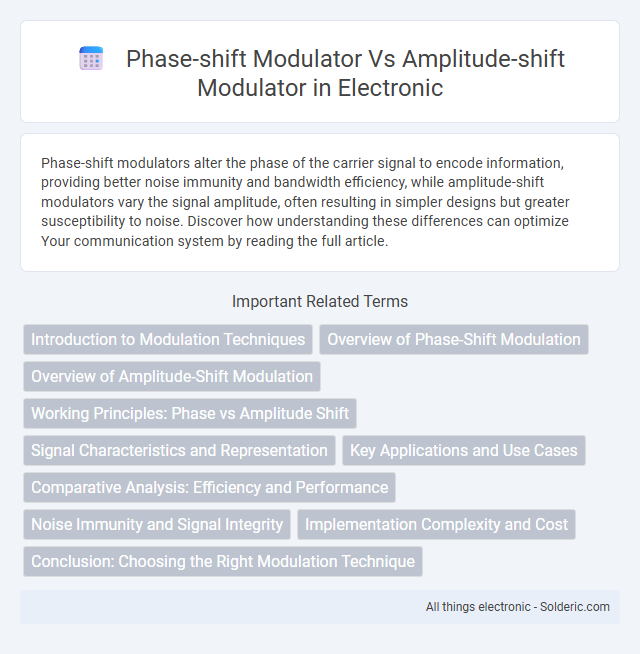Phase-shift modulators alter the phase of the carrier signal to encode information, providing better noise immunity and bandwidth efficiency, while amplitude-shift modulators vary the signal amplitude, often resulting in simpler designs but greater susceptibility to noise. Discover how understanding these differences can optimize Your communication system by reading the full article.
Comparison Table
| Feature | Phase-Shift Modulator (PSK) | Amplitude-Shift Modulator (ASK) |
|---|---|---|
| Modulation Type | Phase change of carrier signal | Amplitude variation of carrier signal |
| Signal Characteristics | Constant amplitude, varying phase | Varying amplitude, constant phase |
| Noise Immunity | High noise resistance | Low noise resistance |
| Bandwidth Efficiency | Higher spectral efficiency | Lower spectral efficiency |
| Power Efficiency | Moderate to high | Lower |
| Complexity | More complex transmitter and receiver | Simple transmitter and receiver |
| Applications | Satellite communication, wireless LANs | Optical communication, low-speed modems |
Introduction to Modulation Techniques
Phase-shift modulators encode information by varying the phase of the carrier signal, enabling higher resistance to noise and improved signal integrity in digital communication systems. Amplitude-shift modulators change the amplitude of the carrier wave to represent data, commonly used in simpler systems but more susceptible to amplitude noise and fading. Both techniques play crucial roles in modulation, driving advancements in bandwidth efficiency and system performance across analog and digital transmission.
Overview of Phase-Shift Modulation
Phase-shift modulation (PSM) alters the phase of the carrier wave to encode information, making it highly effective for minimizing noise interference compared to amplitude-shift modulation (ASM), which varies the amplitude. PSM provides better performance in signal integrity and bandwidth efficiency, crucial for modern digital communication systems. Understanding the benefits of phase-shift modulation helps optimize Your signal transmission by reducing error rates and enhancing data reliability.
Overview of Amplitude-Shift Modulation
Amplitude-Shift Modulation (ASK) is a digital modulation technique where the amplitude of the carrier signal varies in accordance with the binary data, representing different logic levels through distinct amplitude states. ASK systems are simpler to implement but are more susceptible to noise and signal degradation, particularly in environments with amplitude distortion or fading. Compared to Phase-Shift Modulation (PSK), ASK typically offers lower spectral efficiency and reduced robustness, making it more suitable for applications with less stringent noise performance requirements.
Working Principles: Phase vs Amplitude Shift
Phase-shift modulators alter the phase of the carrier signal to represent data, using changes in phase angle while maintaining constant amplitude and frequency. Amplitude-shift modulators encode information by varying the amplitude of the carrier wave while keeping phase and frequency unchanged. The key difference lies in how the carrier wave is manipulated, with phase-shift focusing on phase variations and amplitude-shift on amplitude fluctuations for signal representation.
Signal Characteristics and Representation
Phase-shift modulators encode information by varying the phase of the carrier signal, producing constant amplitude waveforms with distinct phase angles that improve resilience to noise and interference. Amplitude-shift modulators alter the amplitude of the carrier wave while keeping the frequency and phase constant, resulting in varying signal power levels that can be more susceptible to attenuation and noise. Your choice between these modulators impacts signal representation, with phase-shift modulation offering better spectral efficiency and amplitude-shift modulation providing simpler implementation in certain communication systems.
Key Applications and Use Cases
Phase-shift modulators are widely used in advanced communication systems such as digital phase modulation (e.g., QPSK) for wireless networks, satellite communications, and radar signal processing due to their robustness against noise and spectral efficiency. Amplitude-shift modulators find key applications in optical fiber communication and analog amplitude modulation systems, where varying signal amplitude conveys information, ideal for short-distance transmissions and simple circuitry. Your choice between these modulators depends on the required signal integrity, bandwidth efficiency, and specific use case demands in communication system design.
Comparative Analysis: Efficiency and Performance
Phase-shift modulators generally offer higher spectral efficiency and improved noise immunity compared to amplitude-shift modulators, making them more suitable for high-performance digital communication systems. Amplitude-shift modulators, while simpler and less power-consuming, often suffer from greater susceptibility to signal attenuation and distortion, reducing overall transmission reliability. Performance analysis reveals phase-shift modulation typically achieves better bit error rates and bandwidth utilization, crucial for modern broadband applications.
Noise Immunity and Signal Integrity
Phase-shift modulators offer superior noise immunity compared to amplitude-shift modulators due to their reliance on phase changes rather than amplitude variations, making them less susceptible to signal attenuation and amplitude noise. This results in enhanced signal integrity, as phase-based signals maintain coherence even in noisy environments, enabling more reliable data transmission. In contrast, amplitude-shift modulation is more vulnerable to amplitude distortions and noise, leading to degraded signal quality and increased error rates in communication systems.
Implementation Complexity and Cost
Phase-shift modulators generally exhibit higher implementation complexity due to the precision required for phase control and the need for stable reference signals, often leading to increased design and manufacturing costs. In contrast, amplitude-shift modulators offer simpler circuitry and lower cost by directly varying signal amplitude without intricate phase adjustments. The choice between these modulators depends heavily on system requirements where cost-sensitive applications favor amplitude-shift modulation, while phase-shift modulation is preferred in scenarios demanding higher signal integrity and noise resilience.
Conclusion: Choosing the Right Modulation Technique
Phase-shift modulators excel in minimizing noise and interference, making them ideal for high-frequency communication systems requiring robust signal integrity. Amplitude-shift modulators offer simpler implementation and are suitable for short-distance or low-bandwidth applications where power efficiency is less critical. Your choice depends on the specific requirements of your communication system, including bandwidth, noise tolerance, and signal complexity.
Phase-shift modulator vs amplitude-shift modulator Infographic

 solderic.com
solderic.com